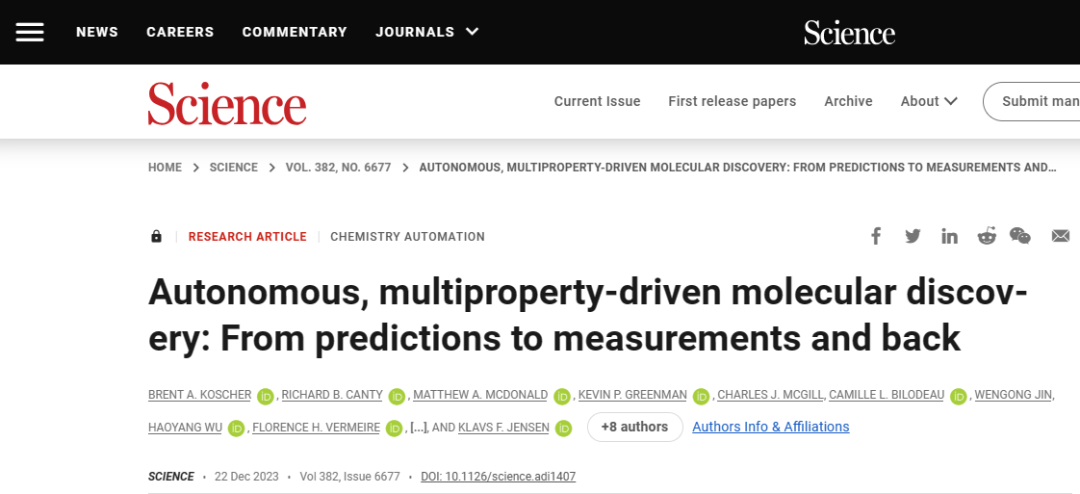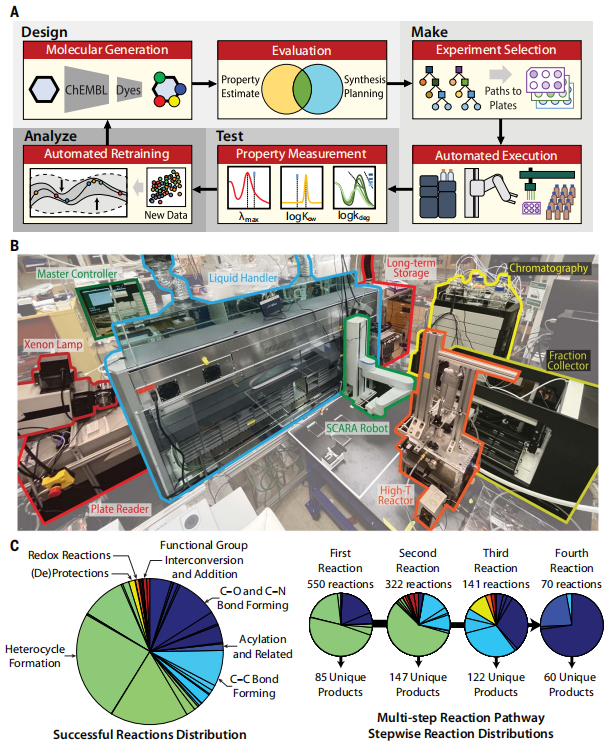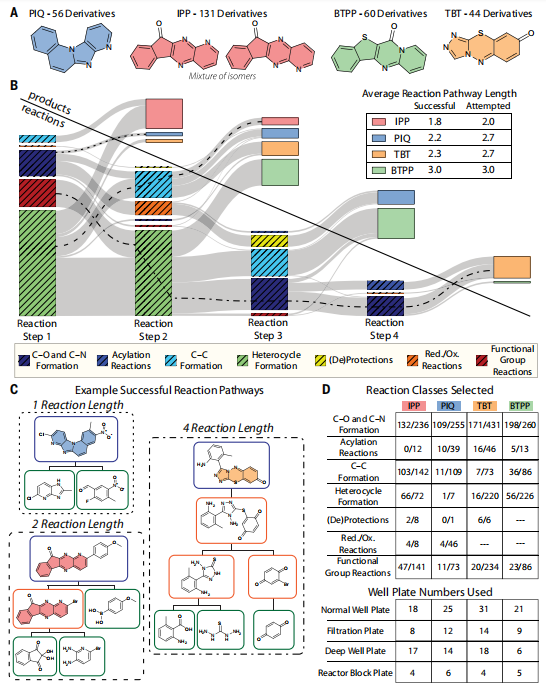 Technology peripherals
Technology peripherals
 AI
AI
 The MIT team used a machine learning closed-loop autonomous molecule discovery platform to successfully discover, synthesize and describe 303 new molecules.
The MIT team used a machine learning closed-loop autonomous molecule discovery platform to successfully discover, synthesize and describe 303 new molecules.
The MIT team used a machine learning closed-loop autonomous molecule discovery platform to successfully discover, synthesize and describe 303 new molecules.

Editor | Pushed.
As chemists increasingly use automated equipment and predictive synthesis algorithms, autonomous research facilities are getting closer.
Recently, researchers from MIT have developed a closed-loop autonomous molecular discovery platform powered by integrated machine learning tools to accelerate the design of molecules with desired properties. Explore chemical space and exploit known chemical structures without manual experimentation.
Across two case studies, the platform attempted more than 3,000 reactions, more than 1,000 of which produced predicted reaction products, and 303 unreported dye-like molecules were proposed, synthesized and characterized.
The study was titled "Autonomous, multiproperty-driven molecular discovery: From predictions to measurements and back" and was published in "Science" on December 22, 2023.
 Paper link: https://www.science.org/doi/10.1126/science.adi1407
Paper link: https://www.science.org/doi/10.1126/science.adi1407
Discover small molecules with desired functional properties Critical to progress in health, energy and sustainability. The process typically proceeds through a slow, laborious, iterative Design-Make-Test-Analyze (DMTA) cycle.
Emerging machine learning (ML) tools can generate new candidate molecules, predict their properties, and propose reaction pathways through computer-aided synthesis planning (CASP). Advances in chemistry automation enable chemical synthesis and characterization with minimal human intervention after manual setup.
Integrating ML generation algorithms, ML property prediction, CASP, robotics, and automated chemical synthesis, purification, and characterization into DMTA workflows enables the development of autonomous chemical discovery platforms that are capable of performing experiments in diverse chemical spaces Run without manual reconfiguration. The ideal property-centric discovery platform would propose and synthesize molecules to enrich machine learning generation and property models, and ultimately discover the best performing molecules. In practice, it is necessary to rule out reactions that cannot be safely performed by the available automation hardware.
To enable autonomous discovery, a research team from MIT demonstrates an integrated DMTA loop that iteratively proposes, implements and characterizes molecules, exploring chemical space guided only by predictive tools.
Graph-completion generates models to design candidate molecules and uses ML models to evaluate them for each of these three properties. The CASP tool proposes multi-step synthesis recipes performed by automated liquid handlers, batch reactors, high-performance liquid chromatography (HPLC), and robotic arms. The plate reader measures absorption spectra, calibrated HPLC retention times provide water-octanol partition coefficients, and a simulated solar light source is combined with the plate reader to quantify photooxidative degradation. Measured molecular properties are automatically fed back to retrain the property prediction model, completing one step of the automated DMTA cycle.
 Overview of the integration platform, and the responses that the platform predicts and successfully executes. (Source: Paper)
Overview of the integration platform, and the responses that the platform predicts and successfully executes. (Source: Paper)
 Explore chemical predictions and attempts at case studies. (Source: Paper)
Explore chemical predictions and attempts at case studies. (Source: Paper)
For both case studies, absorption maximum, partition coefficient, and photooxidation stability were the target properties, and the platform automatically measured and recorded each property to refine model predictions and inform future experimental selections.
The researchers said: "Future iterations of the platform will benefit from improvements in predictive capabilities, particularly reaction fidelity, condition recommendation and molecule generation, as well as analytical tools. The continued development of the closed-loop integrated platform is to continue to accelerate molecular discovery A promising path."
The above is the detailed content of The MIT team used a machine learning closed-loop autonomous molecule discovery platform to successfully discover, synthesize and describe 303 new molecules.. For more information, please follow other related articles on the PHP Chinese website!

Hot AI Tools

Undresser.AI Undress
AI-powered app for creating realistic nude photos

AI Clothes Remover
Online AI tool for removing clothes from photos.

Undress AI Tool
Undress images for free

Clothoff.io
AI clothes remover

AI Hentai Generator
Generate AI Hentai for free.

Hot Article

Hot Tools

Notepad++7.3.1
Easy-to-use and free code editor

SublimeText3 Chinese version
Chinese version, very easy to use

Zend Studio 13.0.1
Powerful PHP integrated development environment

Dreamweaver CS6
Visual web development tools

SublimeText3 Mac version
God-level code editing software (SublimeText3)

Hot Topics
 1377
1377
 52
52
 Breaking through the boundaries of traditional defect detection, 'Defect Spectrum' achieves ultra-high-precision and rich semantic industrial defect detection for the first time.
Jul 26, 2024 pm 05:38 PM
Breaking through the boundaries of traditional defect detection, 'Defect Spectrum' achieves ultra-high-precision and rich semantic industrial defect detection for the first time.
Jul 26, 2024 pm 05:38 PM
In modern manufacturing, accurate defect detection is not only the key to ensuring product quality, but also the core of improving production efficiency. However, existing defect detection datasets often lack the accuracy and semantic richness required for practical applications, resulting in models unable to identify specific defect categories or locations. In order to solve this problem, a top research team composed of Hong Kong University of Science and Technology Guangzhou and Simou Technology innovatively developed the "DefectSpectrum" data set, which provides detailed and semantically rich large-scale annotation of industrial defects. As shown in Table 1, compared with other industrial data sets, the "DefectSpectrum" data set provides the most defect annotations (5438 defect samples) and the most detailed defect classification (125 defect categories
 NVIDIA dialogue model ChatQA has evolved to version 2.0, with the context length mentioned at 128K
Jul 26, 2024 am 08:40 AM
NVIDIA dialogue model ChatQA has evolved to version 2.0, with the context length mentioned at 128K
Jul 26, 2024 am 08:40 AM
The open LLM community is an era when a hundred flowers bloom and compete. You can see Llama-3-70B-Instruct, QWen2-72B-Instruct, Nemotron-4-340B-Instruct, Mixtral-8x22BInstruct-v0.1 and many other excellent performers. Model. However, compared with proprietary large models represented by GPT-4-Turbo, open models still have significant gaps in many fields. In addition to general models, some open models that specialize in key areas have been developed, such as DeepSeek-Coder-V2 for programming and mathematics, and InternVL for visual-language tasks.
 Nature's point of view: The testing of artificial intelligence in medicine is in chaos. What should be done?
Aug 22, 2024 pm 04:37 PM
Nature's point of view: The testing of artificial intelligence in medicine is in chaos. What should be done?
Aug 22, 2024 pm 04:37 PM
Editor | ScienceAI Based on limited clinical data, hundreds of medical algorithms have been approved. Scientists are debating who should test the tools and how best to do so. Devin Singh witnessed a pediatric patient in the emergency room suffer cardiac arrest while waiting for treatment for a long time, which prompted him to explore the application of AI to shorten wait times. Using triage data from SickKids emergency rooms, Singh and colleagues built a series of AI models that provide potential diagnoses and recommend tests. One study showed that these models can speed up doctor visits by 22.3%, speeding up the processing of results by nearly 3 hours per patient requiring a medical test. However, the success of artificial intelligence algorithms in research only verifies this
 Google AI won the IMO Mathematical Olympiad silver medal, the mathematical reasoning model AlphaProof was launched, and reinforcement learning is so back
Jul 26, 2024 pm 02:40 PM
Google AI won the IMO Mathematical Olympiad silver medal, the mathematical reasoning model AlphaProof was launched, and reinforcement learning is so back
Jul 26, 2024 pm 02:40 PM
For AI, Mathematical Olympiad is no longer a problem. On Thursday, Google DeepMind's artificial intelligence completed a feat: using AI to solve the real question of this year's International Mathematical Olympiad IMO, and it was just one step away from winning the gold medal. The IMO competition that just ended last week had six questions involving algebra, combinatorics, geometry and number theory. The hybrid AI system proposed by Google got four questions right and scored 28 points, reaching the silver medal level. Earlier this month, UCLA tenured professor Terence Tao had just promoted the AI Mathematical Olympiad (AIMO Progress Award) with a million-dollar prize. Unexpectedly, the level of AI problem solving had improved to this level before July. Do the questions simultaneously on IMO. The most difficult thing to do correctly is IMO, which has the longest history, the largest scale, and the most negative
 Training with millions of crystal data to solve the crystallographic phase problem, the deep learning method PhAI is published in Science
Aug 08, 2024 pm 09:22 PM
Training with millions of crystal data to solve the crystallographic phase problem, the deep learning method PhAI is published in Science
Aug 08, 2024 pm 09:22 PM
Editor |KX To this day, the structural detail and precision determined by crystallography, from simple metals to large membrane proteins, are unmatched by any other method. However, the biggest challenge, the so-called phase problem, remains retrieving phase information from experimentally determined amplitudes. Researchers at the University of Copenhagen in Denmark have developed a deep learning method called PhAI to solve crystal phase problems. A deep learning neural network trained using millions of artificial crystal structures and their corresponding synthetic diffraction data can generate accurate electron density maps. The study shows that this deep learning-based ab initio structural solution method can solve the phase problem at a resolution of only 2 Angstroms, which is equivalent to only 10% to 20% of the data available at atomic resolution, while traditional ab initio Calculation
 To provide a new scientific and complex question answering benchmark and evaluation system for large models, UNSW, Argonne, University of Chicago and other institutions jointly launched the SciQAG framework
Jul 25, 2024 am 06:42 AM
To provide a new scientific and complex question answering benchmark and evaluation system for large models, UNSW, Argonne, University of Chicago and other institutions jointly launched the SciQAG framework
Jul 25, 2024 am 06:42 AM
Editor |ScienceAI Question Answering (QA) data set plays a vital role in promoting natural language processing (NLP) research. High-quality QA data sets can not only be used to fine-tune models, but also effectively evaluate the capabilities of large language models (LLM), especially the ability to understand and reason about scientific knowledge. Although there are currently many scientific QA data sets covering medicine, chemistry, biology and other fields, these data sets still have some shortcomings. First, the data form is relatively simple, most of which are multiple-choice questions. They are easy to evaluate, but limit the model's answer selection range and cannot fully test the model's ability to answer scientific questions. In contrast, open-ended Q&A
 Automatically identify the best molecules and reduce synthesis costs. MIT develops a molecular design decision-making algorithm framework
Jun 22, 2024 am 06:43 AM
Automatically identify the best molecules and reduce synthesis costs. MIT develops a molecular design decision-making algorithm framework
Jun 22, 2024 am 06:43 AM
Editor | Ziluo AI’s use in streamlining drug discovery is exploding. Screen billions of candidate molecules for those that may have properties needed to develop new drugs. There are so many variables to consider, from material prices to the risk of error, that weighing the costs of synthesizing the best candidate molecules is no easy task, even if scientists use AI. Here, MIT researchers developed SPARROW, a quantitative decision-making algorithm framework, to automatically identify the best molecular candidates, thereby minimizing synthesis costs while maximizing the likelihood that the candidates have the desired properties. The algorithm also determined the materials and experimental steps needed to synthesize these molecules. SPARROW takes into account the cost of synthesizing a batch of molecules at once, since multiple candidate molecules are often available
 SOTA performance, Xiamen multi-modal protein-ligand affinity prediction AI method, combines molecular surface information for the first time
Jul 17, 2024 pm 06:37 PM
SOTA performance, Xiamen multi-modal protein-ligand affinity prediction AI method, combines molecular surface information for the first time
Jul 17, 2024 pm 06:37 PM
Editor | KX In the field of drug research and development, accurately and effectively predicting the binding affinity of proteins and ligands is crucial for drug screening and optimization. However, current studies do not take into account the important role of molecular surface information in protein-ligand interactions. Based on this, researchers from Xiamen University proposed a novel multi-modal feature extraction (MFE) framework, which for the first time combines information on protein surface, 3D structure and sequence, and uses a cross-attention mechanism to compare different modalities. feature alignment. Experimental results demonstrate that this method achieves state-of-the-art performance in predicting protein-ligand binding affinities. Furthermore, ablation studies demonstrate the effectiveness and necessity of protein surface information and multimodal feature alignment within this framework. Related research begins with "S



